
Alpha Centauri is a triple star system in the southern constellation of Centaurus. It consists of three stars: Rigil Kentaurus, Toliman, and Proxima Centauri. Proxima Centauri is the closest star to the Sun at 4.2465 light-years (1.3020 pc).

An exoplanet or extrasolar planet is a planet outside the Solar System. The first possible evidence of an exoplanet was noted in 1917 but was not then recognized as such. The first confirmation of the detection occurred in 1992. A different planet, first detected in 1988, was confirmed in 2003. As of 1 May 2024, there are 5,662 confirmed exoplanets in 4,169 planetary systems, with 896 systems having more than one planet. The James Webb Space Telescope (JWST) is expected to discover more exoplanets, and to give more insight into their traits, such as their composition, environmental conditions, and potential for life.

A neutron star is a collapsed core of a massive supergiant star. The stars that later collapse into neutron stars have a total mass of between 10 and 25 solar masses (M☉), possibly more if the star was especially rich in elements heavier than hydrogen and helium. Except for black holes, neutron stars are the smallest and densest known class of stellar objects. Neutron stars have a radius on the order of 10 kilometers (6 mi) and a mass of about 1.4 M☉. They result from the supernova explosion of a massive star, combined with gravitational collapse, that compresses the core past white dwarf star density to that of atomic nuclei.
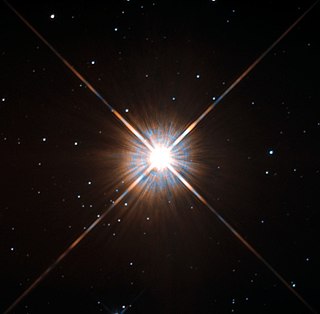
Proxima Centauri is a small, low-mass star located 4.2465 light-years (1.3020 pc) away from the Sun in the southern constellation of Centaurus. Its Latin name means the 'nearest [star] of Centaurus'. It was discovered in 1915 by Robert Innes and is the nearest-known star to the Sun. With a quiescent apparent magnitude of 11.13, it is too faint to be seen with the unaided eye. Proxima Centauri is a member of the Alpha Centauri star system, being identified as component Alpha Centauri C, and is 2.18° to the southwest of the Alpha Centauri AB pair. It is currently 12,950 AU (0.2 ly) from AB, which it orbits with a period of about 550,000 years.

A magnetar is a type of neutron star with an extremely powerful magnetic field (~109 to 1011 T, ~1013 to 1015 G). The magnetic-field decay powers the emission of high-energy electromagnetic radiation, particularly X-rays and gamma rays.
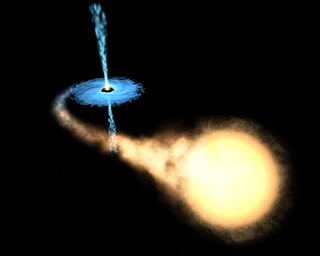
X-ray binaries are a class of binary stars that are luminous in X-rays. The X-rays are produced by matter falling from one component, called the donor, to the other component, called the accretor, which is either a neutron star or black hole. The infalling matter releases gravitational potential energy, up to 30 percent of its rest mass, as X-rays. The lifetime and the mass-transfer rate in an X-ray binary depends on the evolutionary status of the donor star, the mass ratio between the stellar components, and their orbital separation.
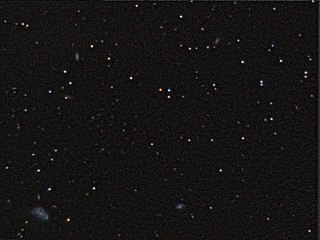
Wolf 359 is a red dwarf star located in the constellation Leo, near the ecliptic. At a distance of 7.86 light-years from Earth, it has an apparent magnitude of 13.54 and can only be seen with a large telescope. Wolf 359 is one of the nearest stars to the Sun; only the Alpha Centauri system, Barnard's Star, and the brown dwarfs Luhman 16 and WISE 0855−0714 are known to be closer. Its proximity to Earth has led to its mention in several works of fiction.
An astronomical radio source is an object in outer space that emits strong radio waves. Radio emission comes from a wide variety of sources. Such objects are among the most extreme and energetic physical processes in the universe.

A K-type main-sequence star, also referred to as a K-type dwarf, or orange dwarf, is a main-sequence (hydrogen-burning) star of spectral type K and luminosity class V. These stars are intermediate in size between red M-type main-sequence stars and yellow/white G-type main-sequence stars. They have masses between 0.6 and 0.9 times the mass of the Sun and surface temperatures between 3,900 and 5,300 K. These stars are of particular interest in the search for extraterrestrial life due to their stability and long lifespan. Many of these stars have not left the main sequence as their low masses mean they stay on the main sequence for up to 70 billion years, a length of time much larger than the time the universe has existed. Well-known examples include Alpha Centauri B and Epsilon Indi.

A flare star is a variable star that can undergo unpredictable dramatic increases in brightness for a few minutes. It is believed that the flares on flare stars are analogous to solar flares in that they are due to the magnetic energy stored in the stars' atmospheres. The brightness increase is across the spectrum, from X-rays to radio waves. Flare activity among late-type stars was first reported by A. van Maanen in 1945, for WX Ursae Majoris and YZ Canis Minoris. However, the best-known flare star is UV Ceti, first observed to flare in 1948. Today similar flare stars are classified as UV Ceti type variable stars in variable star catalogs such as the General Catalogue of Variable Stars.
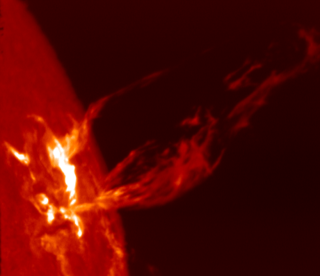
A stellar magnetic field is a magnetic field generated by the motion of conductive plasma inside a star. This motion is created through convection, which is a form of energy transport involving the physical movement of material. A localized magnetic field exerts a force on the plasma, effectively increasing the pressure without a comparable gain in density. As a result, the magnetized region rises relative to the remainder of the plasma, until it reaches the star's photosphere. This creates starspots on the surface, and the related phenomenon of coronal loops.
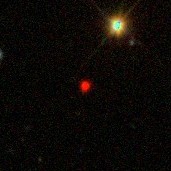
TVLM 513-46546 is an M9 ultracool dwarf at the red dwarf/brown dwarf mass boundary in the constellation Boötes. It exhibits flare star activity, which is most pronounced at radio wavelengths. The star has a mass approximately 80 times the mass of Jupiter. The radio emission is broadband and highly circularly polarized, similar to planetary auroral radio emissions. The radio emission is periodic, with bursts emitted every 7054 s, with nearly one hundredth of a second precision. Subtle variations in the radio pulses could suggest that the ultracool dwarf rotates faster at the equator than the poles in a manner similar to the Sun.

Astrophysical X-ray sources are astronomical objects with physical properties which result in the emission of X-rays.

In radio astronomy, a fast radio burst (FRB) is a transient radio pulse of length ranging from a fraction of a millisecond, for an ultra-fast radio burst, to 3 seconds, caused by some high-energy astrophysical process not yet understood. Astronomers estimate the average FRB releases as much energy in a millisecond as the Sun puts out in three days. While extremely energetic at their source, the strength of the signal reaching Earth has been described as 1,000 times less than from a mobile phone on the Moon.
GJ 625 is a small red dwarf star with an exoplanetary companion in the northern constellation of Draco. The system is located at a distance of 21.1 light-years from the Sun based on parallax, but is drifting closer with a radial velocity of −13 km/s. It is too faint to be visible to the naked eye, having an apparent visual magnitude of 10.13 and an absolute magnitude of 11.06.

An ultra-cool dwarf is a stellar or sub-stellar object that has an effective temperature lower than 2,700 K . This category of dwarf stars was introduced in 1997 by J. Davy Kirkpatrick, Todd J. Henry, and Michael J. Irwin. It originally included very low mass M-dwarf stars with spectral types of M7 but was later expanded to encompass stars ranging from the coldest known to brown dwarfs as cool as spectral type T6.5. Altogether, ultra-cool dwarfs represent about 15% of the astronomical objects in the stellar neighborhood of the Sun. One of the best known examples is TRAPPIST-1.

Proxima Centauri b, sometimes referred to as Alpha Centauri Cb, is an exoplanet orbiting within the habitable zone of the red dwarf star Proxima Centauri, which is the closest star to the Sun and part of the larger triple star system Alpha Centauri. It is about 4.2 light-years from Earth in the constellation Centaurus, making it and Proxima d, along with the currently disputed Proxima c, the closest known exoplanets to the Solar System.

BLC1 was a candidate SETI radio signal detected and observed during April and May 2019, and first reported on 18 December 2020, spatially coincident with the direction of the Solar System's closest star, Proxima Centauri.
Solar radio emission refers to radio waves that are naturally produced by the Sun, primarily from the lower and upper layers of the atmosphere called the chromosphere and corona, respectively. The Sun produces radio emissions through four known mechanisms, each of which operates primarily by converting the energy of moving electrons into electromagnetic radiation. The four emission mechanisms are thermal bremsstrahlung (braking) emission, gyromagnetic emission, plasma emission, and electron-cyclotron maser emission. The first two are incoherent mechanisms, which means that they are the summation of radiation generated independently by many individual particles. These mechanisms are primarily responsible for the persistent "background" emissions that slowly vary as structures in the atmosphere evolve. The latter two processes are coherent mechanisms, which refers to special cases where radiation is efficiently produced at a particular set of frequencies. Coherent mechanisms can produce much larger brightness temperatures (intensities) and are primarily responsible for the intense spikes of radiation called solar radio bursts, which are byproducts of the same processes that lead to other forms of solar activity like solar flares and coronal mass ejections.
















